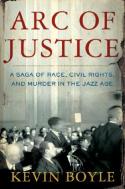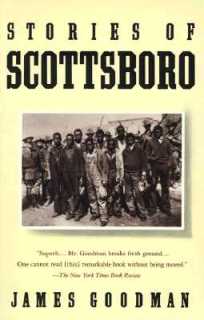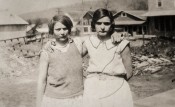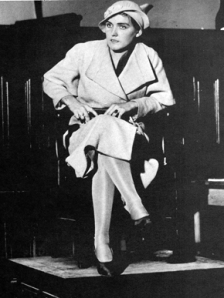The Stories of Scottsboro by James Goodman is a narrative history of nine African-American boys who were put on trial for raping two white girls, Victoria Price and Ruby Bates, on a train traveling through Alabama in 1931. This case gained national attention because it showed the racism in the Southern criminal justice system. These boys were tried and convicted of rape in four separate trials when the evidence overwhelmingly was in their favor. This led many people to believe that the boys were falsely convicted of rape just because they were black. The case also gained notoriety because the Communist Party helped defend the Scottsboro Boys, which showed the impact of the Great Depression during this time. The book also talked about how each person’s different interpretation of history effected their view of the trial and how each person has their own perspectives regarding the events of the trial.
What sets this book apart was that it did not tell a singular narrative of the events. Instead, Goodman portrays these events from many different perspectives such as the African-American boys, the prosecutors, the defense attorney Samuel Leibovitz, representatives of the Communists Party who helped defend the boys, news reporters, and different groups within the Northern and Southern population. This book did an excellent job of showing how these different perspectives affected their view of the trial. One example of this is when a person in charge of the jury rolls took the stand and was questioned by Leibovitz. Leibovitz, a Northerner, thought that Alabama courts systematically and consciously excluded African-Americans from the jury rolls. The court representative agreed that there were few, if any, black jurors but he had a totally different explanation. He said there were no black people who were competent to be jurors. To him the absence of black jurors was such a given that it seemed to be almost invisible. Another example of this is when Leibovitz was fighting with an old Southern judge named Callahan. The judge was blocking almost all of the defense’s motions and Leibovitz was getting extremely frustrated. He thought this old Southern judge was just being racist by trying to disrupt his case. However, the judge thought he was trying to just stick with the events of the case and exclude everything else. He wanted to stick with the events on the train and uphold the dignity of Southern womanhood by not letting Leibovitz attack Victoria Price for being a hobo and a tramp. Callahan also wanted to exclude the influence of the Northerners and Communists as much as possible.
This raises deep postmodern concerns about the justice system and the practice of history. Can there be justice if everybody has their own interpretation of the truth? Can we have objective history if different groups have vastly different understandings of the events and their impact? This seems very pessimistic but Joyce Appleby gives us some hope in her book, Telling the Truth About History (New York, New York: W. W. Norton & Company, 1994). In this book she agrees that absolute truth is unknowable but she says all is not lost. There are still historical records and artifacts that can be a check on the interpretations of historians. While being sensitive of differing perspectives she asserts that if a historical interpretation does not fit with the artifact it should not be believed.
Stories of Scottsboro also showed the impact that history had on the lives of these individuals and the effect that these people had on future events. For instance, Goodman did a character study of each person involved in the case and showed how their past experienced influenced their thinking during the trial. He showed how movies like, Birth of a Nation, made Southerners think Reconstruction was characterized by incompetent African-Americans taking political control thanks to the influence of corrupt Northern carpetbaggers. This influenced their thinking of the trial because they thought the impact of the Northerners and Communists where enacting the same scenario in the Scottsboro Case by letting black rapists go free.
The show American Experience devoted one of their shows to the case entitled, “Scottsboro: An American Tragedy.” This film on the same subject also showed a hint of the current racial dynamic in Alabama by interviewing 2 white men who were alive during the trial. They were hesitant to talk about the trial and wished that the train had stopped and the African-American boys had gotten off at a different location than Scottsboro. This shows that these men probably would admit that there was some racism in the past but they just wanted to ignore itEven though this book and the PBS film dealt with the same content they each had their unique strengths and weaknesses. The book did a much better job talking about larger themes such as the effect of Communism and the Great Depression on these events. This almost 400 page book had the space to go into detail the broader context of the trial. The movie touched on these things but did not delve into these bigger themes as much as Goodman’s book.
This book also did a better job of communicating bigger themes than other
 narrative history books such as The Arc of Justice by Kevin Boyle, which told a Another unique historical theme Goodman’s book brought up is the importance of clothing. This was not the most important theme but it was very interesting and showed up in, surprisingly, a lot of places. For example, one witness was shown to be lying when he assumed the two girls were wearing dresses when they were really wearing overalls. These overalls, in turn, were used to show that Price and
narrative history books such as The Arc of Justice by Kevin Boyle, which told a Another unique historical theme Goodman’s book brought up is the importance of clothing. This was not the most important theme but it was very interesting and showed up in, surprisingly, a lot of places. For example, one witness was shown to be lying when he assumed the two girls were wearing dresses when they were really wearing overalls. These overalls, in turn, were used to show that Price and
Bates were not typical Southern pristine women. They were dirty, poor, hobo woman but they still had more power than the African-American boys. Clothing also came into play when Ruby Bates had a new set of clothing and the defense claimed that she sold out to the Communist to flip her testimony to say she never was raped. These examples show how clothing, as well as gender and race shape the way people thought about these people no matter whether it was justified or not.fascinating story but did not do as good of a job of placing this story in a broadercontext. On the other hand, the medium of the PBS film did a much better job of showing the emotion and turmoil that these boys had gone through during and after the trail. The PBS show displayed this emotion by showing many pictures of the trial, having an authoritative narrator, using an effective soundtrack, and showing interviews with some of the actual participants of the trial themselves.





